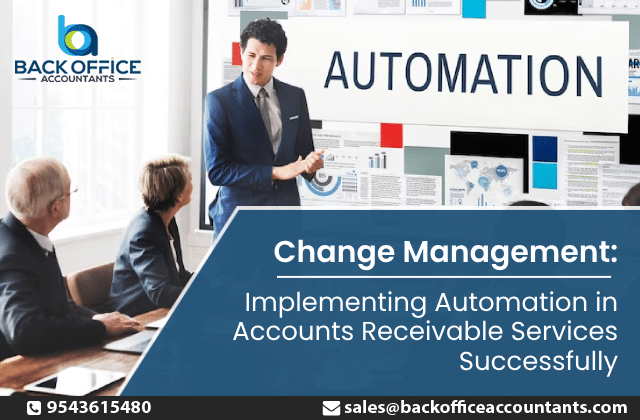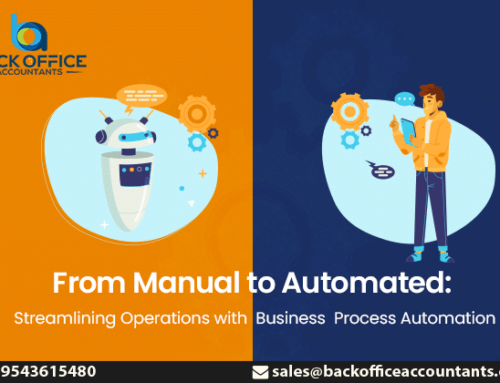Businesses looking to increase productivity, save expenses, and boost satisfaction with clients may consider automating their accounts receivable (AR) services. Automation technology has the ability to accelerate routine activities, reduce mistakes, and make the AR process more flexible and scalable. However, careful planning, efficient change management, and collaboration among departments are all crucial for the effective implementation of automation in AR services.
Organisations must define specific goals, evaluate their present processes, choose the appropriate technology for automation or platforms, and come up with a thorough implementation strategy in order to effectively adopt automation in AR services. For smooth integration and continuous maintenance, collaboration is essential between accounts receivable services teams, IT departments, and outside providers.
Organisations may optimise their financial operations, increase efficiency, and provide better experiences to consumers and stakeholders by adopting automation in AR services and skillfully managing the changes that come along with it.
Understanding the Need for Change
Organisations are continually looking for methods to optimise their accounts receivable and accounts payable processing in the constantly changing world of finance. Understanding the need for change requires an evaluation of the present AR landscape. Paper-based bills, manual data input, and time-consuming reconciliation duties are common components of manual AR processes. These procedures impair cash flow and client satisfaction since they are not only usually inefficient but also prone to many mistakes.
When taking into consideration the advantages it provides, the necessity of accounts payable automation becomes clear. It facilitates quicker processing of invoices, increases accuracy through automated data validation, reduces fines for late payments, and provides transparency into the organisation’s financial situation. Automation also makes it less difficult to stay in line with legal obligations and improves supplier relationships by ensuring prompt payments.
Firms may achieve higher levels of efficiency, cost savings, and strategic value through the implementation of accounts payable automation. But carrying out such an unprecedented shift will need thorough preparation, stakeholder involvement, and efficient change management approaches.
Change Communication, Training, Preparing the Organization for Automation
Accounts receivable services automation implementation necessitates a strategic approach to change management. In order to prepare the organisation for this shift, effective change communication and training are essential. Organisations can guarantee a seamless transition and maximise the success of automation deployment by proactively addressing concerns, articulating the benefits, and offering thorough training.
Raising Concerns and Increasing Awareness:
- Explain why automation is necessary in detail, highlighting any possible advantages like better productivity, fewer mistakes, and more customer satisfaction.
- Address any concerns or worries that staff members may have about their jobs or future positions in a proactive manner.
- Reassure the audience and stress the chances for skill improvement and higher-value contributions.
Stakeholder Engagement:
- Involve important stakeholders in stakeholder engagement. Engage staff members, supervisors, and executives at every stage of the procedure to get their perspectives, handle their issues, and win their support.
- This partnership develops a sense of ownership and a favourable outlook on the change.
- These are some conditions when using a spinal cord stimulator can help.
Detailed Instruction:
- Determine the precise abilities and information needed to use the automation programme efficiently. Make a comprehensive examination to customizethe training programme.
- Provide practical instruction to staff with useful, hands-on training that enables them to become familiar with the accounts payable automationtools, workflows, and best practices.
- Promote active engagement and continuing assistance.
Overcoming Barriers to Change
Employee resistance is one of the main obstacles to change. Organisations must properly convey the advantages of automation to avoid this. Organisations may allay worries and win support by clearly articulating how automation can eliminate repetitive jobs, streamline processes, and free up staff to concentrate on more strategic and value-added activities.
The lack of knowledge and understanding regarding automation is another frequent hurdle. Organisations should spend money teaching staff members about the advantages and operation of automation technology in order to overcome this issue. Employees may better grasp how automation might enhance their job and the overall efficiency of AR services by being given sessions of instruction, workshops, and resources for learning.
Back Office Accounts ought to be on your consideration list while looking for bookkeeping and accounting services. Back Office Accounts distinguishes itself as a partner for companies in need of financial management help due to its remarkable competence and a broad array of services.
Back Office Accounts has a staff of very talented individuals that are knowledgeable about bookkeeping and accounting procedures. Their knowledge covers several sectors, guaranteeing that they can successfully meet the particular needs and demands of various enterprises. Back Office Accounts offers the knowledge and experience to offer solutions that are in line with your distinctive financial goals, whether you have a big business or a small startup.







